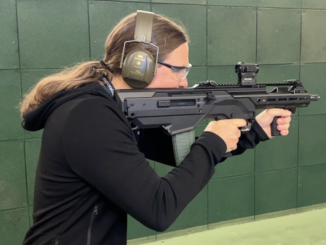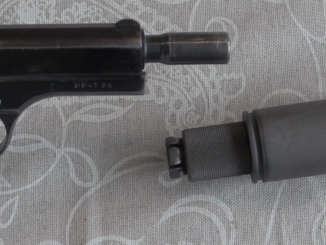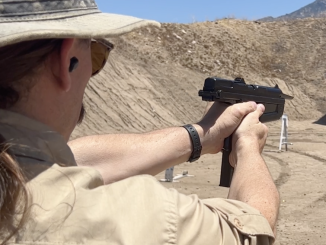As part of the Warsaw Pact, Poland anticipated adopting the AK-74 after it was developed by the Soviet Union. However, the eventual Soviet terms for license fees and export restrictions were too severe for Polish taste. Instead, Poland opted to develop its own new rifle to use the 5.45x39mm cartridge. This would essentially be a 5.45mm version of the AKM. That sounds like an AK-74, but the 74 actually involved a significant number of changes to parts which the Poles though could be leave identical tot he AKM (like the rear trunnion, for instance). The Poles also wanted to separate the selector lever into two separate controls, with a safety lever on the right and a selector lever (including a 3-round burst option) on the left side.
This new project, codenamed Tantal, was adopted as the wz.88 just before the collapse of the Soviet Union. Production ran for only a couple years, with a total production of 30-50 thousand rifles. Once it became clear that Poland had a path to join NATO, the Tantal was dropped in anticipation of a new rifle in 5.56x45mm NATO. For much more information on the Tantal, see Leszek Erenfeicht’s extensive article.




Thanks to Ian for shedding light on this, somehow mysterious (at lest to me) Polish development. I gather that due to traditional Polish-Russian misgivings, there was some apprehension to adopt soviet rifle straight thru license. However, what kind of puzzles me is why they would not develop a rifle jointly with Czechs, who were proceeding in mid of 80s in much the same direction. There has been a history of joint military hardware projects between both nations (personal armored transporters for instance). https://en.wikipedia.org/wiki/%C4%8CZ_2000
Having said that I like to point out my appreciation for different trigger mechanism and grenade launcher capability Polish designers added to the master design.
“(…)mysterious(…)”
Then you might be interested in SJ-57 which was developed by Bolesław Jurek in mid-1950s, firing 7,62×39 mm cartridge, see 2nd row from top, 3rd column from left here http://www.muzeumpw.com.pl/news,184.htm
Sadly I do not have English language description of this weapon, so might only inform that it was short-recoil and point you to photos available there http://bcpw.bg.pw.edu.pl/Content/5870/Jurek_6.pdf
“(…)why they would not develop a rifle jointly with Czechs(…)”
There was own People’s Polish Republic rifle which even used own unique 7 x 41 LANTAN cartridge, see lower half of 1st photo from top here:
http://cartridgecollector.net/7-x-41-lantan
“(…)launcher capability Polish designers(…)”
They apparently so loved that they included it in Onyks (equivalent of AKS-74U)
Thanks for additional information. I understand Polish language quite well. When in my old country I used to buy Polish periodicals.
“(…)has been a history of joint military hardware projects between both nations(…)”
Also, Poland acquired and used Czechoslovak-made P-27 see photos https://www.valka.cz/CZK-Pancerovka-27-t37213
The story reminds me of the FN Browning Hi Power / P-35.
Ah, the dreaded rifle rack problem! US rifle racks prevent mounting the Aimpoint forward on the upper receiver, which of course limits clip-ons behind the optic, such as magnifiers. Which illustrates another issue – the longer a particular item is in inventory, the greater institutional resistance to replacing it.
It’s a rare weapon that takes the routines of actual day-to-day operations into account.
M16? Classic case. Serial number is on the side of the magazine well, which means that you have to pull the damn thing out of the rack to do the serial number inventory. Garand? They had the serial number right there on the top of the receiver, easily visible without pulling the weapon out of the rack.
I’m not sure why they do this–Anyone with about a month’s worth of experience in running an Arms Room could tell you all the many and varied issues with the way everything utterly fails to work together. Another question yet to be answered is why they issue racks that are open, and completely useless as transit containers. How hard would it be to build something that’s capable of doing both?
The Marines bar-code all their weapons; Army does not. Why not? How hard would it be to automate all the weapons issue BS, most of which is still locked into the dark ages, done on pen-and-paper that is utterly useless when the time comes to track who had what weapon signed out when, mainly due to the illegibility of the signatures and handwriting.
To my way of thinking, the entire system needs to be set up in such a way that it actually reflects how the weapons are used–Current weapons issues have to include all the accessories and other goodies that come with the rifle, which manifestly will not fit into the racks designed to fit the M16. So, why aren’t they integrating everything, and designing the storage/security systems to handle that?
Even the relatively primitive situation back when I was the PFC-in-charge of things, it was an idiotic nightmare of confusion. It’s like “Oh, it’s an alert…? Lemme go run open the arms room and issue everything within the proscribed 30 minutes…”. Which was not happening because a.) there was more than just the rifles to go out b.) inevitably, absences of assigned personnel would mean that crew-served equipment assigned to them wouldn’t be signed out by anybody, and until the leadership noticed that they were without their assigned night vision for their one weapon that had it, well… Yeah. I remember one alert where about half the company was absent due to taskings like funeral detail, and I’m sitting there in the Arms Room with all of my 90mm recoilless systems still in the racks, and about half my M60s still waiting for someone to come pick them up. This was some 2 1/2 hours after the alert was called, and I still hadn’t been able to get my crap loaded onto a truck.
People have this false image of how well-coordinated all these things are, and I’m here to tell you, it simply is not. I’ve seen situations where we got an alert and got out of dodge well within the time frame allotted us, and it took two days to straighten out the issue paperwork for the Arms Room, because the armorer was just handing stuff over without doing any kind of tracking as he did it. We were literally lining guys up in the field, strip-searching them and recording every single serial number all over again, just to have them sign out on a new register. Other times, the armorer followed all the rules he was supposed to, and we wound up taking four hours just to get to the point where we could roll out the gates.
You look at stuff like what happened at Isandlwana, where the Quartermasters supposedly wouldn’t issue ammunition without the right paperwork as they were being overrun, and you think “No way could something like that happen…”. Reality? Something like that could still happen to this day, and I would believe it with no problems. Some mornings, I’d have actually been more surprised that we managed to get off the “X” without something like this tripping us up.
Bureaucracy and administrivia probably kills more people at the outset of wars than the enemy does, TBH.
Put the SN where it can be seen in the rifle rack, & someone will design a storage container that doubles as a rack, which puts the weapon bottom up – which the Army will buy, and the Marines will get when the Army gets the next shiny thing.
More than likely. Which is why you put your boot on the neck of the idiots designing and integrating that stuff, and don’t take it off until you’re happy with the results.
I shudder to think at the number of man-hours wasted on things like serial number inventories that could be done ever so much more quickly if only someone sat down and recognized that the admin requirements eat up huge amounts of time and effort. Not to mention, when you design a system in such a way that it’s almost certain to be circumvented, don’t be really surprised when people circumvent it. Overly onerous requirements for the admin stuff at the issue window are begging to be ignored, and likely will be–Which will create even more problems for the institution as a whole.
Case in point–Most bases (they all have final say over things like how weapons get issued…) require that there be two forms of accountability for every sensitive item (weapons, sights, other things stored in your Arms Room…) before it goes out. Normal circumstances, that means you have a weapon’s card and sign a register, but if your normal weapon isn’t available or you have to take out someone else’s, then you have to do a temporary hand receipt and sign the register. If every guy going to the issue window has like five things to sign out, which isn’t that unlikely…? Yeah; you’re looking at literal hours to get a company-sized element through the mill. During an alert, forget about it; you either throw the regulations out the window, or you don’t make the time hacks required.
In a lot of cases, I think we’ve really allowed the administrative overhead tail to take over wagging the real-world dog. They really need to start looking at things from a standpoint of either permanently issuing everything out to the soldier and holding them accountable like grownups, or maybe doing something like making the fire control parts separate modules that are all they have to secure in the Arms Room. At the rate things are going, by the time you get done adding in all the separate little bits-and-bobs like sights, lasers, bayonets, and all the rest, the poor bastard individual soldier is going to be carrying a pocketful of weapon’s cards and be signing his signature enough to generate a pretty good case of carpal tunnel syndrome…
We managed pretty well on deployments with the guys having their stuff 24/7. I don’t know why on earth we couldn’t be doing the same in garrison, with some relatively minor tweaks.
I do think, however, that someone is going to have to start looking seriously at doing that deal with the fire control mechanisms and leaving the rest of the weapon on permanent issue with its accessories. Nothing else is really going to work, with all the required accessories we have these days.
It’s odd that they chose to move the selector rather than the safety to the more ergonomic position.
Dust cover, Mike, dust cover.
I understand that the safety (sorta) serves that function on the AKM, but it also serves as the mode selector.
Several AK derivatives attach a lever to the opposite side of the safety / selector shaft to place it near the right thumb in firing position. I see no reason why the Poles couldn’t have either done that or, if they really wanted to separate the functions, leave the selector to cover the charging-handle slot and use a separate left-side safety.
Some might argue that ergonomic preferences vary because not everyone is built the same. That’s true to a point, but requiring the same finger to perform near-simultaneous actions in two different places is not ergonomic for anyone. Safety deactivation is far more likely to be time-critical than fire mode selection. Along the lines of your other comments about procedures and workarounds, putting a safety where one can’t deactivate it fast enough to return fire makes troops more likely to stop using the safety.
As an aside, how many 5.45 mm guns were built versus 7.62 x 39 mm guns have been built, especially since the collapse of USSR in 1991?
The Polish guns were probably better quality than the Russian ones (although whether that makes a difference on the battlefield?). As an example, the first thing the Poles (and Czechs) would do when they got Russian made vehicles was pull the power packs and replace them with units rebuilt locally. All those metal chips left in the crankcase and blocking oil and water passages…
All Czecho-Slovak army trucks were of domestic production (Tatra and Praga). The Russian trucks in times of their military presence in CSSR were colloquially called 100/100. It meant fuel consumption of 100liter on 100km driven. They typically left train of oil on pavement – sure telltale they passed thru there. On soviet bases was left a huge fuel/ oil pollution; in some cases it was not fully cleaned to this day. That was then, now their KAMAZ trucks are world class.
It’s perhaps worth adding that these rifles were also equipped with a detachable bipod.
They were issued to elite troops. I still swore my oath – which included allegiance to the aeternal friendship with Soviet Union (which the Soviet Union broke, going to hell shortly thereafter) – carrying a good old AKM. Nearby paratroopers from the 6th Brigade/Division (a Brigade which pretended to be a division) had Tantals, which we envied. Whether rightly, I am not sure.
I suppose the AKM was okay. At least it did its job well, right?
During 1968 invasion the Poles were the least keen participants. I recall one Polish trooper after talk with our guys, took mag out of his rifle and as sign of solidarity tossed it into nearby pond. Couple of years later, when was unrest in Poland I was afraid to be called to service and sent there. Luckily for me it did not happen.
I think Czechs, Slovaks, and Poles tended to thumb their noses at Moscow whenever the Russians weren’t looking. Stupid politicians dragging normal folk into their messes is nothing new.